| Entry | Database: PDB / ID: 6k0t
|
|---|
| Title | Crystal Structure of PPARgamma Ligand Binding Domain in complex with dibenzooxepine derivative compound-17 |
|---|
 Components Components | - Peroxisome proliferator-activated receptor gamma
- Peroxisome proliferator-activated receptor gamma coactivator 1-alpha
|
|---|
 Keywords Keywords | NUCLEAR PROTEIN / PPARgamma / Ligand binding domain / PPARg modulator / Cancer |
|---|
| Function / homology |  Function and homology information Function and homology information
Regulation of MITF-M dependent genes involved in metabolism / positive regulation of fatty acid oxidation / cellular respiration / Activation of PPARGC1A (PGC-1alpha) by phosphorylation / prostaglandin receptor activity / : / negative regulation of receptor signaling pathway via STAT / MECP2 regulates transcription factors / negative regulation of vascular endothelial cell proliferation / negative regulation of extracellular matrix assembly ...Regulation of MITF-M dependent genes involved in metabolism / positive regulation of fatty acid oxidation / cellular respiration / Activation of PPARGC1A (PGC-1alpha) by phosphorylation / prostaglandin receptor activity / : / negative regulation of receptor signaling pathway via STAT / MECP2 regulates transcription factors / negative regulation of vascular endothelial cell proliferation / negative regulation of extracellular matrix assembly / negative regulation of connective tissue replacement involved in inflammatory response wound healing / positive regulation of cholesterol transport / negative regulation of cellular response to transforming growth factor beta stimulus / arachidonate binding / positive regulation of adiponectin secretion / negative regulation of cardiac muscle hypertrophy in response to stress / DNA binding domain binding / lipoprotein transport / positive regulation of vascular associated smooth muscle cell apoptotic process / WW domain binding / response to starvation / temperature homeostasis / positive regulation of fatty acid metabolic process / STAT family protein binding / response to lipid / lncRNA binding / response to muscle activity / negative regulation of type II interferon-mediated signaling pathway / LBD domain binding / negative regulation of cholesterol storage / intracellular glucose homeostasis / negative regulation of SMAD protein signal transduction / fatty acid oxidation / response to dietary excess / lipid homeostasis / E-box binding / alpha-actinin binding / R-SMAD binding / negative regulation of vascular associated smooth muscle cell proliferation / monocyte differentiation / negative regulation of blood vessel endothelial cell migration / white fat cell differentiation / cellular response to low-density lipoprotein particle stimulus / negative regulation of macrophage derived foam cell differentiation / negative regulation of lipid storage / negative regulation of BMP signaling pathway / positive regulation of cholesterol efflux / cell fate commitment / adipose tissue development / negative regulation of osteoblast differentiation / negative regulation of mitochondrial fission / FOXO-mediated transcription of oxidative stress, metabolic and neuronal genes / positive regulation of fat cell differentiation / BMP signaling pathway / long-chain fatty acid transport / brown fat cell differentiation / nuclear retinoid X receptor binding / Transcriptional regulation of brown and beige adipocyte differentiation by EBF2 / retinoic acid receptor signaling pathway / energy homeostasis / cell maturation / digestion / negative regulation of MAPK cascade / intracellular receptor signaling pathway / hormone-mediated signaling pathway / positive regulation of adipose tissue development / response to nutrient / peroxisome proliferator activated receptor signaling pathway / epithelial cell differentiation / regulation of cellular response to insulin stimulus / positive regulation of gluconeogenesis / peptide binding / SUMOylation of transcription cofactors / RNA splicing / negative regulation of miRNA transcription / negative regulation of angiogenesis / placenta development / Regulation of PTEN gene transcription / nuclear receptor binding / positive regulation of apoptotic signaling pathway / transcription coregulator binding / gluconeogenesis / transcription coregulator activity / respiratory electron transport chain / mitochondrion organization / transcription initiation at RNA polymerase II promoter / SUMOylation of intracellular receptors / circadian regulation of gene expression / negative regulation of smooth muscle cell proliferation / negative regulation of transforming growth factor beta receptor signaling pathway / mRNA transcription by RNA polymerase II / Heme signaling / Transcriptional activation of mitochondrial biogenesis / PPARA activates gene expression / fatty acid metabolic process / regulation of circadian rhythm / PML body / chromatin DNA binding / Nuclear Receptor transcription pathway / Transcriptional regulation of white adipocyte differentiationSimilarity search - Function PGC-1alpha, RNA recognition motif / PGC-1 / Peroxisome proliferator-activated receptor gamma / Peroxisome proliferator-activated receptor gamma, N-terminal / PPAR gamma N-terminal region / Peroxisome proliferator-activated receptor / : / Retinoid X Receptor / Retinoid X Receptor / RNA recognition motif ...PGC-1alpha, RNA recognition motif / PGC-1 / Peroxisome proliferator-activated receptor gamma / Peroxisome proliferator-activated receptor gamma, N-terminal / PPAR gamma N-terminal region / Peroxisome proliferator-activated receptor / : / Retinoid X Receptor / Retinoid X Receptor / RNA recognition motif / RNA recognition motif / Eukaryotic RNA Recognition Motif (RRM) profile. / RNA recognition motif domain / RNA-binding domain superfamily / Nuclear hormone receptor / Nuclear hormones receptors DNA-binding region signature. / Zinc finger, nuclear hormone receptor-type / Double treble clef zinc finger, C4 type / Nuclear hormone receptors DNA-binding domain profile. / c4 zinc finger in nuclear hormone receptors / Nuclear hormone receptor, ligand-binding domain / Nuclear hormone receptor-like domain superfamily / Ligand-binding domain of nuclear hormone receptor / Nuclear receptor (NR) ligand-binding (LBD) domain profile. / Ligand binding domain of hormone receptors / Zinc finger, NHR/GATA-type / Nucleotide-binding alpha-beta plait domain superfamily / Orthogonal Bundle / Mainly AlphaSimilarity search - Domain/homology Chem-CTU / Peroxisome proliferator-activated receptor gamma / Peroxisome proliferator-activated receptor gamma coactivator 1-alphaSimilarity search - Component |
|---|
| Biological species |  Homo sapiens (human) Homo sapiens (human) |
|---|
| Method |  X-RAY DIFFRACTION / X-RAY DIFFRACTION /  SYNCHROTRON / SYNCHROTRON /  MOLECULAR REPLACEMENT / Resolution: 1.84 Å MOLECULAR REPLACEMENT / Resolution: 1.84 Å |
|---|
 Authors Authors | Suzuki, M. / Yamamoto, K. / Takahashi, Y. / Saito, J. |
|---|
 Citation Citation |  Journal: Bioorg.Med.Chem. / Year: 2019 Journal: Bioorg.Med.Chem. / Year: 2019
Title: Development of a novel class of peroxisome proliferator-activated receptor (PPAR) gamma ligands as an anticancer agent with a unique binding mode based on a non-thiazolidinedione scaffold.
Authors: Yamamoto, K. / Tamura, T. / Nakamura, R. / Hosoe, S. / Matsubara, M. / Nagata, K. / Kodaira, H. / Uemori, T. / Takahashi, Y. / Suzuki, M. / Saito, J.I. / Ueno, K. / Shuto, S. |
|---|
| History | | Deposition | May 7, 2019 | Deposition site: PDBJ / Processing site: PDBJ |
|---|
| Revision 1.0 | Oct 30, 2019 | Provider: repository / Type: Initial release |
|---|
| Revision 1.1 | Nov 6, 2019 | Group: Data collection / Database references / Category: citation / Item: _citation.journal_volume |
|---|
| Revision 1.2 | Nov 6, 2024 | Group: Data collection / Database references / Structure summary
Category: chem_comp_atom / chem_comp_bond ...chem_comp_atom / chem_comp_bond / database_2 / pdbx_entry_details / pdbx_modification_feature
Item: _database_2.pdbx_DOI / _database_2.pdbx_database_accession |
|---|
|
|---|
 Yorodumi
Yorodumi Open data
Open data Basic information
Basic information Components
Components Keywords
Keywords Function and homology information
Function and homology information Homo sapiens (human)
Homo sapiens (human) X-RAY DIFFRACTION /
X-RAY DIFFRACTION /  SYNCHROTRON /
SYNCHROTRON /  MOLECULAR REPLACEMENT / Resolution: 1.84 Å
MOLECULAR REPLACEMENT / Resolution: 1.84 Å  Authors
Authors Citation
Citation Journal: Bioorg.Med.Chem. / Year: 2019
Journal: Bioorg.Med.Chem. / Year: 2019 Structure visualization
Structure visualization Molmil
Molmil Jmol/JSmol
Jmol/JSmol Downloads & links
Downloads & links Download
Download 6k0t.cif.gz
6k0t.cif.gz PDBx/mmCIF format
PDBx/mmCIF format pdb6k0t.ent.gz
pdb6k0t.ent.gz PDB format
PDB format 6k0t.json.gz
6k0t.json.gz PDBx/mmJSON format
PDBx/mmJSON format Other downloads
Other downloads 6k0t_validation.pdf.gz
6k0t_validation.pdf.gz wwPDB validaton report
wwPDB validaton report 6k0t_full_validation.pdf.gz
6k0t_full_validation.pdf.gz 6k0t_validation.xml.gz
6k0t_validation.xml.gz 6k0t_validation.cif.gz
6k0t_validation.cif.gz https://data.pdbj.org/pub/pdb/validation_reports/k0/6k0t
https://data.pdbj.org/pub/pdb/validation_reports/k0/6k0t ftp://data.pdbj.org/pub/pdb/validation_reports/k0/6k0t
ftp://data.pdbj.org/pub/pdb/validation_reports/k0/6k0t Links
Links Assembly
Assembly


 Components
Components Homo sapiens (human) / Gene: PPARG, NR1C3 / Production host:
Homo sapiens (human) / Gene: PPARG, NR1C3 / Production host: 
 Homo sapiens (human) / References: UniProt: Q9UBK2*PLUS
Homo sapiens (human) / References: UniProt: Q9UBK2*PLUS X-RAY DIFFRACTION / Number of used crystals: 1
X-RAY DIFFRACTION / Number of used crystals: 1  Sample preparation
Sample preparation SYNCHROTRON / Site:
SYNCHROTRON / Site:  Photon Factory
Photon Factory  / Beamline: BL-17A / Wavelength: 0.98 Å
/ Beamline: BL-17A / Wavelength: 0.98 Å Processing
Processing MOLECULAR REPLACEMENT / Resolution: 1.84→40 Å / Cor.coef. Fo:Fc: 0.956 / Cor.coef. Fo:Fc free: 0.927 / SU B: 9.2 / SU ML: 0.136 / Cross valid method: THROUGHOUT / ESU R: 0.148 / ESU R Free: 0.146 / Details: HYDROGENS HAVE BEEN ADDED IN THE RIDING POSITIONS
MOLECULAR REPLACEMENT / Resolution: 1.84→40 Å / Cor.coef. Fo:Fc: 0.956 / Cor.coef. Fo:Fc free: 0.927 / SU B: 9.2 / SU ML: 0.136 / Cross valid method: THROUGHOUT / ESU R: 0.148 / ESU R Free: 0.146 / Details: HYDROGENS HAVE BEEN ADDED IN THE RIDING POSITIONS Movie
Movie Controller
Controller


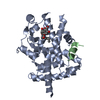





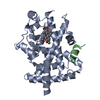
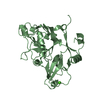


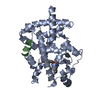


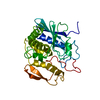
 PDBj
PDBj










